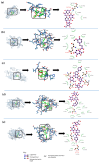Enzymatic Fructosylation of Phenolic Compounds: A New Alternative for the Development of Antidiabetic Drugs
- PMID: 38999025
- PMCID: PMC11243490
- DOI: 10.3390/molecules29133072
Enzymatic Fructosylation of Phenolic Compounds: A New Alternative for the Development of Antidiabetic Drugs
Abstract
Enzymatic fructosylation has emerged as a strategy to enhance the hydrophilicity of polyphenols by introducing sugar moieties, leading to the development of phenolic glycosides, which exhibit improved solubility, stability, and biological activities compared to their non-glycosylated forms. This study provides a detailed analysis of the interactions between five phenolic fructosides (4MFPh, MFF, DFPh, MFPh, and MFPu) and twelve proteins (11β-HS1, CRP, DPPIV, IRS, PPAR-γ, GK, AMPK, IR, GFAT, IL-1ß, IL-6, and TNF-α) associated with the pathogenesis of T2DM. The strongest interactions were observed for phlorizin fructosides (DFPh) with IR (-16.8 kcal/mol) and GFAT (-16.9 kcal/mol). MFPh with 11β-HS1 (-13.99 kcal/mol) and GFAT (-12.55 kcal/mol). 4MFPh with GFAT (-11.79 kcal/mol) and IR (-12.11 kcal/mol). MFF with AMPK (-9.10 kcal/mol) and PPAR- γ (-9.71 kcal/mol), followed by puerarin and ferulic acid monofructosides. The fructoside group showed lower free energy binding values than the controls, metformin and sitagliptin. Hydrogen bonding (HB) was identified as the primary interaction mechanism, with specific polar amino acids such as serin, glutamine, glutamic acid, threonine, aspartic acid, and lysine identified as key contributors. ADMET results indicated favorable absorption and distribution characteristics of the fructosides. These findings provide valuable information for further exploration of phenolic fructosides as potential therapeutic agents for T2DM.
Keywords: ADMET; molecular docking; phenolic fructosides; polyphenols; type 2 diabetes mellitus.
Conflict of interest statement
The authors declare no conflicts of interest.
Figures


Similar articles
-
Multi-Targeted Molecular Docking, Pharmacokinetics, and Drug-Likeness Evaluation of Okra-Derived Ligand Abscisic Acid Targeting Signaling Proteins Involved in the Development of Diabetes.Molecules. 2021 Oct 1;26(19):5957. doi: 10.3390/molecules26195957. Molecules. 2021. PMID: 34641501 Free PMC article.
-
Fructosylation of phenolic compounds by levansucrase from Gluconacetobacter diazotrophicus.Enzyme Microb Technol. 2019 Mar;122:19-25. doi: 10.1016/j.enzmictec.2018.12.004. Epub 2018 Dec 4. Enzyme Microb Technol. 2019. PMID: 30638505
-
Exploring Holy Basil's Bioactive Compounds for T2DM Treatment: Docking and Molecular Dynamics Simulations with Human Omentin-1.Cell Biochem Biophys. 2025 Mar;83(1):793-810. doi: 10.1007/s12013-024-01511-6. Epub 2024 Sep 11. Cell Biochem Biophys. 2025. PMID: 39259407
-
In Silico Approaches to Identify Polyphenol Compounds as α-Glucosidase and α-Amylase Inhibitors against Type-II Diabetes.Biomolecules. 2021 Dec 14;11(12):1877. doi: 10.3390/biom11121877. Biomolecules. 2021. PMID: 34944521 Free PMC article. Review.
-
Functionalization of natural compounds by enzymatic fructosylation.Appl Microbiol Biotechnol. 2017 Jul;101(13):5223-5234. doi: 10.1007/s00253-017-8359-5. Epub 2017 Jun 8. Appl Microbiol Biotechnol. 2017. PMID: 28593337 Review.
References
-
- Lizárraga-Velázquez C.E., Leyva-López N., Hernández C., Gutiérrez-Grijalva E.P., Salazar-Leyva J.A., Osuna-Ruíz I., Martínez-Montaño E., Arrizon J., Guerrero A., Benitez-Hernández A., et al. Antioxidant molecules from plant waste: Extraction techniques and biological properties. Processes. 2020;8:1566. doi: 10.3390/pr8121566. - DOI
MeSH terms
Substances
Grants and funding
LinkOut - more resources
Full Text Sources
Medical
Research Materials
Miscellaneous

